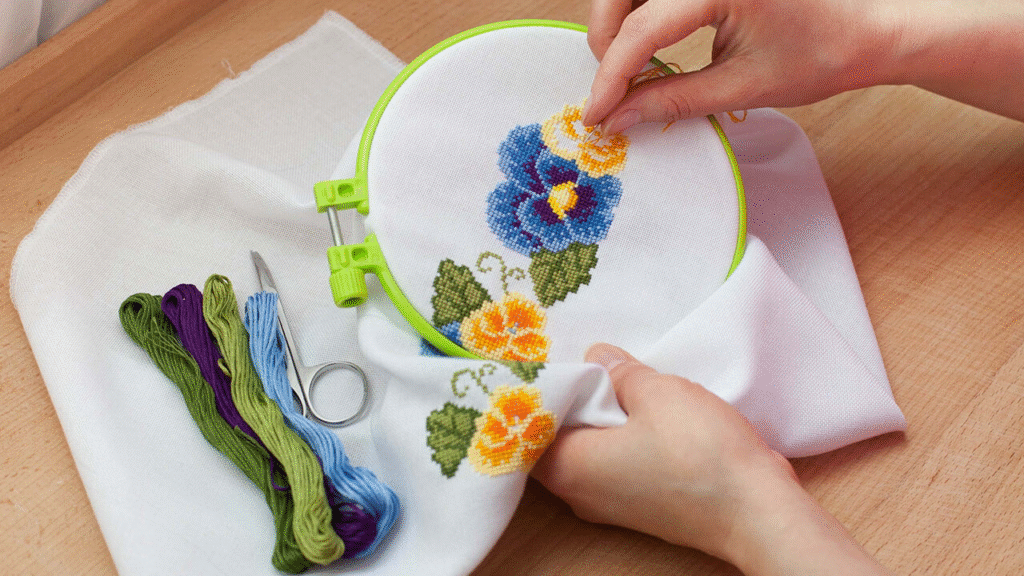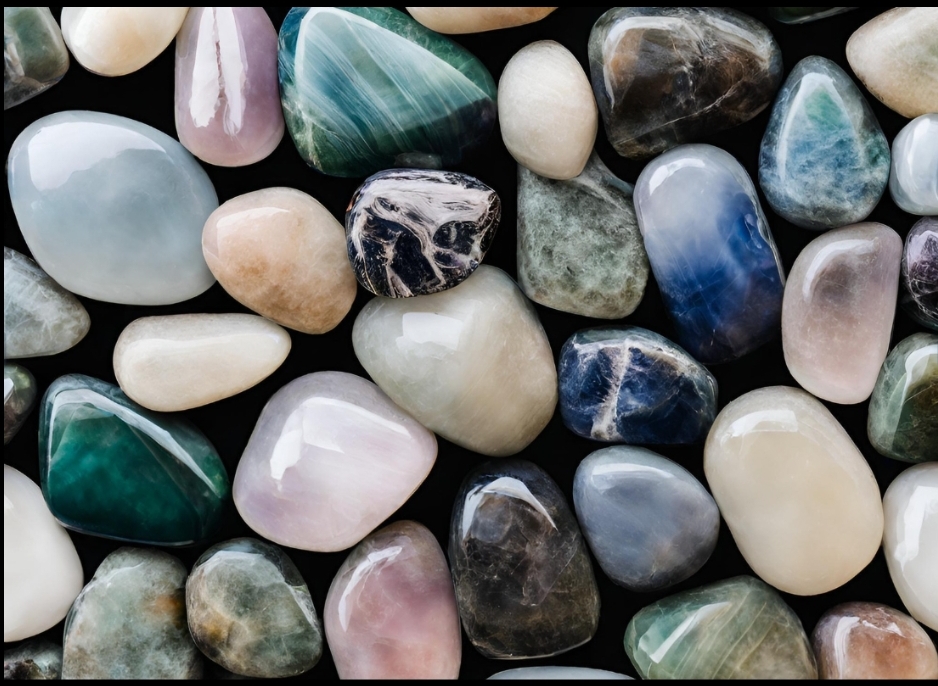Hand embroidery is an art form that uses needlework to change fabric into a thing of beauty. It reveals social history and expresses a culture’s artistic character through the medium of the skilled needlewoman. In different parts of the world, a variety of techniques have come into being, each with different stitches, patterns, and reasons for their existence. Hand embroidery is mainly for the embellishment of clothes, household decorative items like a saree, kurta, or home textiles by pattern stitched. This write-up is dedicated to different types of hand embroidery, which it explains by showing their charming characteristics and cultural value.
1. Running Stitch Embroidery
The running stitch is the simplest one among hand embroidery and is usually the basic one for transferring simple designs. The thing is that this method is used where the needle is passed regularly through the fabric creating a zigzag pattern. This technique can be applied to the art of Kantha work in India, from the most elementary designs to the most intricate patterns. It is just easy and hence is the best option for beginners and at the same time, it has its own charm in the old textiles. The running stitch technique of embroidery is often introduced as a way of adding delicate features in sarees and quilts.
2. Satin Stitch Embroidery
Satin stitch is the technique that gives an even, shiny, and filled appearance by placing parallel stitches tightly to completely cover the shape and create an effect of the most refined texture. The technique is regularly applied to motifs of flowers, inscriptions, and commendable designs that ask for a flat one-color combination. It is essential for the person working on the fabric with a margin of error but do it with precision to avoid distorted edges; this is one of the reasons for the implementation of satin stitch in the case of cushion covers where decorative art is concerned. In Indian instances, the surface designs for silk wear by the satin stitch make the produced effect seem even more real and vivid. A major part of bridal wear and festive attire is the smooth and luxurious finish coming from satin stitching.
3. Chain Stitch Embroidery
Chain stitch is an embroidery technique made by lots of loops which, apparently, like a chain gaining a 3D effect. It originated from Kashmiri and Persia and is famous for the performance of different actions in the making of a garment. Stitch is the core of the stitch while the colors are the outliner and the pattern is also very intricate. By using this method of work, one can cater to all requirements of delicacy through the thick effect. This type of stitching is found in Indian clothing such as Phulkari and Kashmiri shawls and is responsible for one simple reason, flowl. The technique is very famous as it can be used for whatever creations: be it clothes or room settings.
4. Aari Embroidery
Aari embroidery, also known as crewel work, makes use of a hooked needle to establish chainlike stitches, predominantly with colorful threads and beads. Coming from Gujarat, Aari work has speed as a main advantage and is widely popular for the creation of the details in the flowers and paisley motifs. Aari work is definitely one of the things that could bring out the beauty of Navratri Lehenga Choli, anarkalis, and house decorations as the threads are so vivid and the stitches so textured. The versatility of Aari embroidery is the main reason why it is chosen repeatedly in both traditional and contemporary fashion. Aari embroidery definitely brings a lot more to the table when it comes to any piece of garment or home décor from a creative perspective.
5. French Knot Embroidery
When we speak of French knot embroidery, we mean creating tiny, little knots of thread around the needle tip, and when knotted, those knots form tiny texture balls. This technique is very popular in Indian Chikankari work, where designers mainly focus on the textured effects to make the flowers look as real as possible. Mastering the skills required in this technique might be a bit difficult, but you can nonetheless be assured of the fine and soft texture it provides to the fabric. French knots can represent one of the simplest ways to add a little hint of style when we talk about how we can take advantage of this kind of work intentionally for very light fabrics like cotton and muslin. Because a single kind of stitch hardly meets the requirements of highly ornate embroidery, they are often applied in a layer format. They’re often combined with other stitches for intricate, layered embroidery.
6. Kantha Embroidery
Kantha is perhaps the best example of embroidery that was born in Bengal and employs staple stitches only to generate graphic designs, traditionally worn, either by patching or quilting, fabrics. Historically, it was the presentation of old clothes not used for age or for other reasons that were exclusively then copied into quilts with the help of traditional, including religious designs. These quilted pieces were also embroidered with running stitches. This simple and repetitive stitching served as the most effective way of showing solidarity with nature and local artistry (it’s the rhythm of the stitches that makes Kantha meaningful).
7. Phulkari Embroidery
Phulkari, approximately “flower work,” is another cultural embroidery from Punjab, which is represented by vivid floral patterns in bold threads, almost entirely on rough cotton. Long, straight darning stitches are applied in such a way as to ensure the fabric is completely covered, hence creating a rich, textured exterior. Phulkari shawls and dupattas were typically worn by women during festivities. But these accessories have now become a worldwide fashion statement. The colors and patterns of the craft are a vivid reflection of Punjab’s cultural joy and enjoyment.Are Phulkari. In other words, Phulkari is still a cherished craft which is still giving its roots back while it is also appealing as a mod…
8. Chikankari Embroidery
Chikankari is a very fine and intricate kind of Embroidery sarees originally from the city of Lucknow. It became globally popular because of its very delicate, white-on-white thread work on light materials such as muslin and cotton. Further, a lot of the time, designers incorporate items such as satin, herringbone, and French knot stitches to produce flowers and paisley fabric patterns, and very often by adding shadow-work features to achieve a deeper dimension. As the name implies, the art was much loved by royalty with Chikankari even considered as the present. It has however continued growing and as of today it is not only confined to royal families but has spread to common folks, and in particular to kurta and saree wearers. The various, airy designs of Chikankari are a perfect carrying item in summer as well as a must-have for such formal occasions having all eyes on you. It is the simplicity yet stylishness that gives Chikankari its own unique identity.
9. Zardozi Embroidery
Zardozi, the luxurious embroidery that is of Persian influence, makes use of mainly gold or silver threads with the addition of beads and sequins for creating a very rich type of pattern. At that time of the Mughals, kings and queens did not select anything else but zardozi for their special occasions the reason it became an integral part of many of their clothes such as the bridal lehengas and the beautifully-embroidered sarees. The artisan must have the skills needed to transform gold and silver threads into patterns that are characterized by their longevity and complete liveliness. Zardozi creates the idea of splendor, thus, this technique used for wedding dresses or any festive occasion is the most demanded. Actually, it has continually preserved and perpetuated its charm and sway so that it appeals to the present generations of couturiers and style devotees.
10. Kasuti Embroidery
Kasuti is the art of embroidery from the state of Karnataka which is quite intricate, featuring counted-thread patterns mainly in black, red, or orange on handspun cloth. However, it is not necessarily restricted to these colors. The dot, running, and other types of stitches are the ones that are mainly responsible for this geometric and folk-inspired type of decoration. These designs are even so basic that almost anyone can do it; either side of the patterns is the same. This tradition of the Ilkal saree is full of messages from that time, if we may say so, so designs that depict villagers and the topics from spirituality are predominant. A delicate hand is a must when one is engaged in this embroidery work as there are to be no knots seen in the design and this accounts for the final tone of the look. The idea of simplicity, which is carried to the highest level, is what Kasuti is all about, and that is enough to make it a classic among Indian textiles.
11. Cross Stitch Embroidery
Cross-stitch or counted-thread embroidery is a famous form of stitching that uses X-shaped stitches to form colorful patterns, mostly following a pre-drawn design for accuracy. It’s a globally known technique, widely integrated into European folk art and the latest DIY trends. Designs can be quite as simple as small motifs and as intricate as whole scenes. The sole representation from India is that of cross-stitch work and it appears in varied forms throughout the country. Kasuti, a street art of Karnataka, is one of the different forms of cross stitch used in India. The process of producing cross stitch is of such a type that it is open and still quite capable of creating art which is personal and deeply meaningful. This type of embroidery is so special and one-of-a-kind.
Hand embroidery exerts a spectacle of different patterns, and techniques are each recounting a unique. One of the techniques is the rapid growth, and renaissance of the art of embroidery, but there are more stitches to see in the spectacle of hand embroidery that is not only the running stitch but there is also the Zardosi stitch that is very luxurious. Unveiling the different embroidery and the different types of stitching found in them, the piece of textiles rises to the level of art indeed. For example, not only the embroidery of a saree, kurta, or quilt bridges the gap between traditional and modern fashion but it also embellishes. The new types of trends that are derived from these designs are very interesting, inspiring, and increasing the attraction of the artistry. The secret of their popularity lies in the cadastral power of the seamstresses nurturing the history of every thread.





